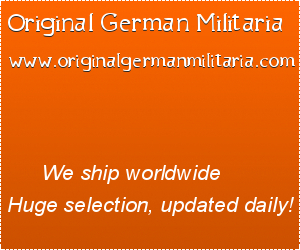Afrikakorps Kriegsmarine Pith Helmet
SKU: 23.GOR.01.02.02.002
Estimated market value:


Estimated market value:
Attributes
History
During the Second World War, German troops stationed in northern Africa are generally referred to as the Afrikakorps. Technically, this is not entirely correct, since some German units operating in Africa were not actually part of the DAK (Deutsches Afrikakorps), and some units of it were, in fact, Italian ones. However, for the purpose of collecting so-called “tropical” uniforms and insignia, collectors have simplified the meaning of the term.
The first German troops were sent to northern Africa in February of 1941, to support their Italian allies against the British. The climate of the African continent made it necessary to wear specialised uniforms and gear that not only supported the soldiers in serving in a hot and arid environment, but also helped them in blending in with the landscape, which, in general, presented itself as brown, olive, khaki, or sand/tan in colour. Worn over long periods of time under the blistering desert sun, some uniforms were eventually bleached to white or off-white. Uniforms and insignia in these colours are often referred to as “tropical”, and it is worth noting that they weren’t just worn by members of units stationed in Africa, but in the entire Mediterranean theatre of war, including southern France, Italy, the Balkans, and Greece, as well as in southern Russia during the summer months. Tropical uniforms were worn by members of all three branches of the Wehrmacht: the Heer (army), the Kriegsmarine (navy), and the Luftwaffe (air force). Members of the Waffen-SS stationed in southerly regions also wore tropical-style uniforms, and even though they technically have no connection to the DAK, all tropical uniforms and insignia of all branches of the German military are listed here.
The Pith Helmet was not meant to serve as protection against projectiles, but mainly to shield the wearer from the heat and the sun.
There are several iterations of the pith helmet dating back to 1856 in the Kingdom of Prussia. The pith helmets issued during the Third Reich are based upon the English style helmets adopted from February 14, 1930 onward. These English style helmets were primarily manufactured by the Ludwig Bortfeldt firm in Bremen.
While these early pith helmets underwent several design amendments, the pith helmets worn during the Second World War fall into two main patterns. The 1st pattern pith helmets were issued in 1940, while the 2nd pattern pith helmets were issued in 1941. Both of these patterns were based upon the helmet design submitted by the Gustav Barre firm in Berlin, which incorporated the ventilation lug system pioneered by the earlier Model-1902 tropical helmets. Although the Second World War pith helmets were only officially commissioned in 1940, they were withdrawn from general service wear in 1943, as a result of the dissatisfaction in use by Kriegsmarine personnel.
The Kriegsmarine pith helmets are composed of several main elements, including the pressed compression cork shell, the helmet cover, the cap band, the wide brim, the visor trim, the leather chin strap, the leather sweatband, the lining, and the manufacturer’s logo/stamp.
Each pith helmet was also adorned with insignia. From 1934-1941, the pith helmets feature insignia associated with general ranks groups, but from mid-1941 onward the pith helmets are only decorated with two shield insignia. Specifically, the early pith helmets for Officers feature double gilt braids on the cap band, and the early pith helmets for all ranks from Officer Candidate and up have a gilt brocade strip on the cap band, as well as a Reichskokarde and the national emblem above the cap band. When the new model of the pith helmet was issued in 1940, all rank insignia on the pith helmets were removed and replaced by a single gold-coloured national emblem above the cap band; the national emblem is silver-coloured for the pith helmets of Administrative Officials with the rank of Officer. These changes were short lived, and the national emblems were replaced with Navy pattern shields by mid-1941. The Navy pattern shields on pith helmets include the national tricolour shield on the right side and the gold-coloured Wehrmacht eagle shield on the left side; the eagle shield is silver-coloured for Administrative Officials. Both shields were manufactured without the embossed outer edge trim, as seen on Heer pattern shields, and with rounded corners.
From 1940 onward, the pith helmets were issued in white or tan/khaki fabric/canvas covers. These covers are generally composed of linen, wool, or cotton cloth. The first pattern helmet covers are composed of six swatches of fabric over the helmet dome, while the second pattern covers are composed of a single piece of fabric over the helmet dome. The helmets with a white cover generally feature a white leather trim, while those with a tan cover generally feature a brown leather trim.
The brim of the Second World War pith helmets is longer at the back, to provide additional protection to the wearer’s neck.
The interior lining is composed of light green to dark green cloth.


Comments
Sign in to comment and reply.


Scroll Top